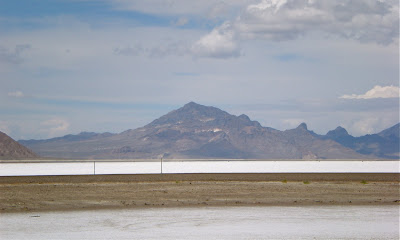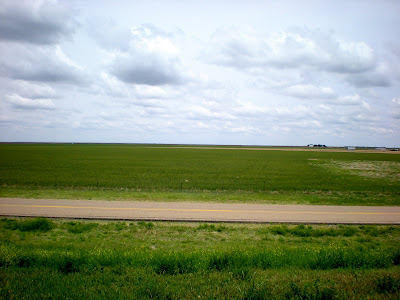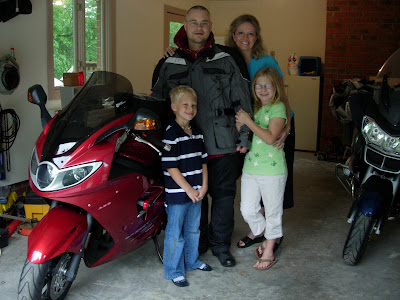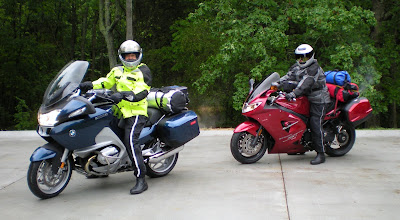
Everybody talks about the Grand Canyon. Why doesn’t anybody bother to mention the Painted Desert and the Petrified Forest? I’m not sure what tomorrow holds in terms of our Grand Canyon experience, but if it’s in the same ballpark as what we saw today then our eyes just might pop out of our heads.
When we left Gallup, New Mexico this morning, it was 39 degrees. During the day, we suffered through a 56 degree temperature change. For those who are not math inclined, the high today on our ride was 95 degrees. It stayed above 90 for most of the afternoon, and we hit 95 around 3:00 p.m. at a Rest Area about 40 miles east of Flagstaff, Arizona. Of course, we drank a lot of water (although I made fun of him at first, Dad’s idea to put a little cooler on the back of his motorcycle has paid dividends) and wore our lightest gear.
I am now four out of five on state line signs. Arizona had a magnificently large one that photographed well. You’ll note that the Welcome Center was named after the Painted Cliffs, which were nearby. I took some photos of this area, but it seems that the painted cliff was nothing more than a recent tourist attraction aimed at drawing folks to a row of shops (which seemed abandoned now).
At the entrance to the Painted Desert/Petrified Forest (they are connected, so they’re pretty much the same thing), I sprung for the annual National Park Service pass. It was our first National Park on our trip, so I calculated that it would be more cost effective and efficient to have the pass. I got a neat little windshield sticker for the Triumph.
The first thing we saw in the park was the Painted Desert Inn, which is a National Historic Landmark (two photos are in the album). Originally constructed between 1937 and 1940 using some leftover materials from an earlier inn dating from the 1920s, the inn was refurbished and reopened in 2006 as a museum and bookstore.
The photos I took of the Painted Desert cannot do it justice. Every day I see something new that I cannot believe exists in the world. Makes me wonder why I’ve waited so long to see them. The Painted Desert had many features, but the most notable was the badlands area. According to the park information, the term badlands originated with indigenous people of Montana and the Dakotas. The phrase
mako sica literally meant “badland.” Later, Spanish trappers described such regions as
el malpais, again “badlands.” Today, the term refers to a spectacular, highly eroded landscape.
Pintado Point was probably the best view in the park. In the distance, Pilot Rock rose above everything else. It is the mountain you see behind Dad and me in our solo photos. Also, although you cannot see them in the photo, it is possible to see the San Francisco Peaks, which, sad to say, are not in San Francisco. They are near Flagstaff, and are known at The Peaks in that area. The highest point is Humphreys Peak. You will be able to see Humphreys Peak in some later photos.
Once we entered the Petrified Forest, red was no longer the dominant color. There really wasn’t one here. Our first stop was Newspaper Rock, which was an ancient type of community newspaper. Newspaper Rock contains the largest collection of petroglyphs in the park. A petroglyph is an image carved in rock that is meant to tell a story or symbolize an event or occurrence. I hope you can see them in my photo.
What we were most amazed by was the variety in the Painted Desert/Petrified Forest. Yes, there lots of huge landscapes that sometimes seem alike, but we couldn’t believe how many different types of geological features were found so close together. We passed formations called “The Teepees” and “Blue Mesa” and “Agate Bridge,” just to name a few. You will find photos of most of these in the album.
Finally, though, the petrified wood took the prize for best in show. It’s no wonder they chose to name the park in this manner. Petrified wood is actually a fossil, which means that it has been buried under sediment for so long that the organic materials in the wood have been replaced with minerals. The petrified wood retains the same shape as its original piece. You will see many samples of petrified wood in the album, including a couple of close ups and one really huge log.
Finally, please pay attention to the drastic climate shift from the second to last rest area to the last rest area. One was a full-blown desert, and the other looked like Sherwood Forest (not really, but almost). The transition was startling, especially as we had not seen any pine trees since Arkansas (so it seemed), and the transition occurred in less than 50 miles.
Well, I wrote a lot tonight. Let’s hope the Grand Canyon is as fruitful.
246.6 miles today. 2,140.8 total miles.
 We made it!
We made it!
































